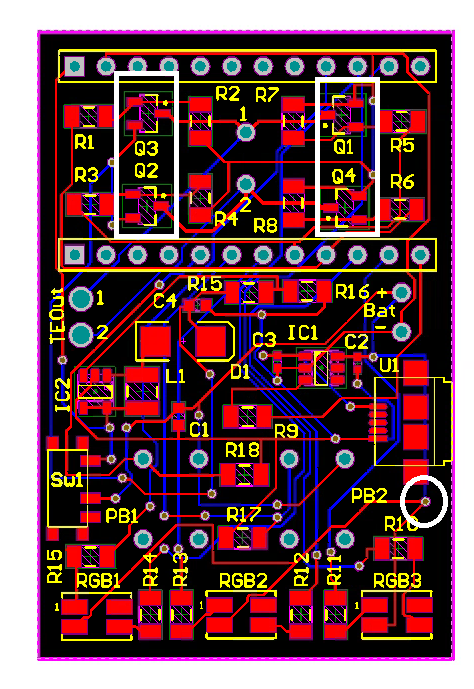What I accomplished this week
The two main things I did this week was troubleshoot my circuit and I wrote up details of the test procedure that will occur.
So, last week, I ran into an issue where the MCU would shut off when I added the DigitalWrite(HeatPulse, HIGH); or DigitalWrite(ColdPulse, HIGH); to my code. This sends a HIGH signal to the gate of the transistors that allow current to flow to the thermoelectric module. For ‘HeatPulse’ the high voltage bus connects to the positive lead and then the low voltage bus is connected to ground. When this occurs, heat is drawn from one side of the TE module to the other. For ‘ColdPulse’, the polarity is reversed and causes heat to be transferred in the opposite direction. This system of transistors to enables a voltage to be applied across a load in either direction is called a H-Bridge.
As stated earlier, when I send a signal to trigger these MOSFETs, it shuts down the MCU. I measured the initial battery voltage and it was 3.7v and when the signal was sent, it was only 0.8v. So based on those observations, I reasoned that the large current draw from the thermoelectric module is causing the voltage to dip so I need to try a stronger power supply. Ross was kind enough to provide me with a computer power supply that had 3.3v, 5v, 9v, and 12v in abundance quantities, unlike my little battery. So I found the 3.3v line in the jumble of cables and desoldered my battery and soldered the power supply lines to my board. Unfortunately, the test results were less than desirable. The circuit board booted up and in less than five seconds, I noticed smoke coming from my board. It took me a bit to identify which component was burning up, but then I noticed the position of the inductor had shifted. Yes, the pads had heated up past the melting temperature of the solder. I fried the inductor in the voltage boosting sub-circuit.Inference: There is a short that appears only when either set of transistors’ paths
Unfortunately, the test results were less than desirable. The circuit board booted up and in less than five seconds, I noticed smoke coming from my board. It took me a bit to identify which component was burning up, but then I noticed the position of the inductor had shifted. Yes, the pads had heated up past the melting temperature of the solder. I fried the inductor in the voltage boosting sub-circuit.Inference: There is a short that appears only when either set of transistors’ paths
Inference: There is a short that appears only when either set of transistors’ paths are closed. This could be a design issue or fabrication issue (i.e. soldered incorrect component or accidental solder bridge, wouldn’t be the first time)
After hours of testing the circuit and analyzing schematics and analyzing PCB layouts, I have yet to determine the exact cause of the circuit though.
Next Week’s Work
I am going to discuss via email with Kevin Ponto who is currently in France for a VR conference and hopefully, we can diagnose the issue. If we cannot, then I am going to make a sacrifice and go with only cooling so I’ll have something presentable for the Undergraduate Research Symposium.

